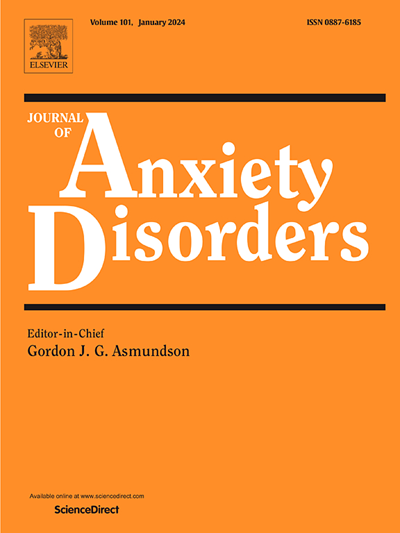A comparison of virtual reality and verbal imaginal exposure for childhood anxiety disorders
IF 4.5
2区 医学
Q1 PSYCHIATRY
引用次数: 0
Abstract
Virtual reality is a promising tool for improving efficacy of exposure therapy for childhood anxiety disorders (CADs), particularly for exposures that are challenging to orchestrate in vivo. The present study compared virtual reality exposure (VRE) to verbal imaginal exposure (IE) on anxiety elicited, homework completion, and preparation for subsequent exposures. Forty-five youth with CADs completed both types of exposure in session (order randomly assigned), practiced one form of exposure as homework (randomly assigned), and returned a week later to repeat both exposures (in randomized order), provide user feedback, and complete a related in vivo exposure. Both VRE and IE elicited moderate anxiety that decreased to mild during the exposure and were associated with lower initial anxiety ratings in subsequent exposures. These patterns did not differ across exposure type. The two techniques did not differ on homework completion. VRE was associated with greater simulator (motion) sickness symptoms. Participants rated VRE as more realistic than IE and noted pros and cons for both approaches. The present study supported use of VRE and IE in treatment of CADs without demonstrating superiority of either technique in effectiveness or homework completion.
儿童焦虑障碍的虚拟现实与言语想象暴露的比较。
虚拟现实是一种很有前途的工具,可以提高暴露疗法对儿童焦虑症(CADs)的疗效,特别是对那些难以在体内协调的暴露。本研究比较了虚拟现实暴露(VRE)与言语想象暴露(IE)在焦虑诱发、家庭作业完成和后续暴露准备方面的差异。45名患有cad的年轻人在会议中完成了两种类型的暴露(随机分配的顺序),练习了一种形式的暴露作为家庭作业(随机分配),一周后返回重复两种暴露(随机顺序),提供用户反馈,并完成相关的体内暴露。VRE和IE都引起中度焦虑,在暴露期间减少到轻度,并且在随后的暴露中与较低的初始焦虑评分相关。这些模式在不同的暴露类型中没有差异。这两种方法在完成家庭作业方面没有差异。VRE与更大的模拟器(运动)病症状相关。参与者认为VRE比IE更现实,并指出了两种方法的优缺点。本研究支持使用VRE和IE治疗cad,但没有证明任何一种技术在有效性或完成作业方面的优势。
本文章由计算机程序翻译,如有差异,请以英文原文为准。
求助全文
约1分钟内获得全文
求助全文
来源期刊

Journal of Anxiety Disorders
Multiple-
CiteScore
16.60
自引率
2.90%
发文量
95
期刊介绍:
The Journal of Anxiety Disorders is an interdisciplinary journal that publishes research papers on all aspects of anxiety disorders for individuals of all age groups, including children, adolescents, adults, and the elderly. Manuscripts that focus on disorders previously classified as anxiety disorders such as obsessive-compulsive disorder and posttraumatic stress disorder, as well as the new category of illness anxiety disorder, are also within the scope of the journal. The research areas of focus include traditional, behavioral, cognitive, and biological assessment; diagnosis and classification; psychosocial and psychopharmacological treatment; genetics; epidemiology; and prevention. The journal welcomes theoretical and review articles that significantly contribute to current knowledge in the field. It is abstracted and indexed in various databases such as Elsevier, BIOBASE, PubMed/Medline, PsycINFO, BIOSIS Citation Index, BRS Data, Current Contents - Social & Behavioral Sciences, Pascal Francis, Scopus, and Google Scholar.
 求助内容:
求助内容: 应助结果提醒方式:
应助结果提醒方式:


